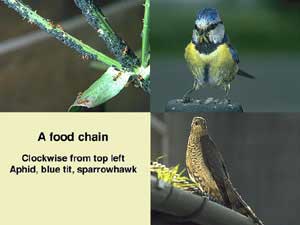Plants convert energy from sunlight into energy stored in chemicals such as sugars or starch stored inside them. Animals are not able to get energy from sunlight in this way, and so they eat plant material, or other animals which have eaten the plant material. The plants are called 'producers' and the animals which feed on them 'consumers'. This dependence of one organism on another working back to a 'producer' is called a 'food chain'. One example of a food chain is: - plants -
- aphids -
- blue tits -
- sparrowhawk
It is noticeable that for consumers, further along the chain the organisms get larger, and there are fewer of them. In other words, we have a pyramid of numbers of the organisms. In the case of the food chain above we would have thousands of aphids, and a few blue tits to one sparrowhawk.
|
|

An example of a simple food chain - aphids feed on plants, blue tits eat the aphids, sparrowhawks will eat blue tits.
|

![[Advert]](../../images/ad/content.gif)

![[Advert]](../../images/ad/content.gif)